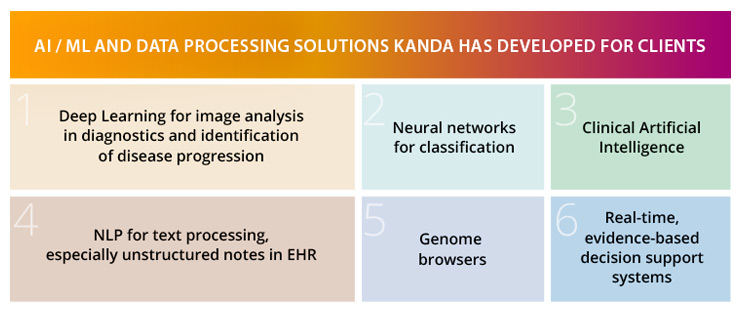
From Electronic Health Records (EHRs) to health related apps and devices, the volume and complexity of Real-World Data (RWD) being generated in Healthcare and Life Sciences requires specialized approaches to successfully transform it into actionable Real-World Evidence (RWE). This is where Artificial Intelligence (AI) and Machine Learning (ML) become essential. Whether its automated data processing and standardization, or classification algorithms that can assist in cohort identification for clinical trials, or predictive algorithms that assist in understanding patient behavior – AI can play an instrumental role in deriving RWE insights from sets of Real-World Data.
The most common AI and Machine Learning methods that we work to develop with our clients can be segmented into a few different categories, the first of which is Natural Language Processing (NLP). NLP algorithms are specifically designed to handle unstructured text data, and are often used to provide automatic summarization of the main points in a given text or document such as physician notes in EHRs. These algorithms eliminate the need for time consuming manual reviews while simultaneously enhancing patient data and improving the understanding and accuracy of diagnoses, disease progression and patient treatment plans.
Another area in which we have extensive experience working with partners and providing them support is Clinical Artificial Intelligence, the use of machine learning algorithms to mimic human cognition in the comprehension and analysis of complex healthcare data. We’ve helped a handful of clients develop products that are capable of identifying a significantly broader range of patients for chronic condition management with an impressive degree of accuracy, thereby increasing patient enrollment and participation while simultaneously lowering overhead costs for providers.

Kanda has also helped a number of clients by assisting in the building of systems engineered for clinical decision making. One such platform consists of configurable practice, lab and payer modules that facilitate real-time, evidence-based support, enabling oncologists to know precisely which tests to order for which patients and from which labs. The modules can then help them interpret the results for more informed treatment decisions, all while adhering to the patient’s specific insurance policies. This ML driven system provides oncologists with a sense of reassurance in knowing that they’ve ordered the most relevant tests based on the respective progression of their patient’s disease and their individual clinical stage.
Deep Learning for image analysis that assists in diagnostics and the identification of disease progression is another relatively common area of Machine Learning which we often encounter when working with clients in the Life Sciences industry. The rise of advanced deep learning methods has paved the way for successful medical image analysis with high accuracy, stability, efficiency and scalability. These algorithms are primarily designed to provide a comprehensive understanding of autoimmune diseases and assist in drug discovery and drug repurposing investigations.
It’s worth noting that developing any of these AI / ML solutions should go hand in hand with the right technology and the right data infrastructure. We engage with our clients in order to truly understand the needs and challenges that they encounter when they want to leverage their Real-World Data to facilitate progress and drive innovation. By collaborating closely with our partners, we develop solutions that combine the right dynamic and scalable infrastructure with intuitive and automated data management systems and with robust Artificial Intelligence and Machine Learning algorithms.



